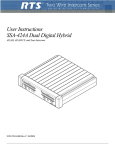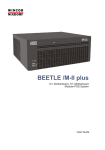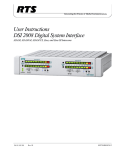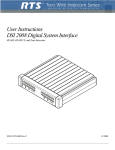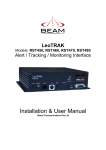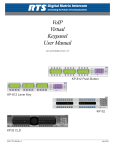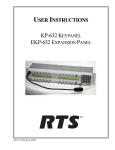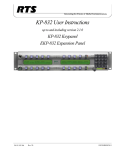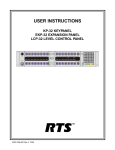Download RTS SSA-424A User manual
Transcript
User Instructions SSA-424 Dual Digital Hybrid ADAM™, ADAM CS™, Zeus™ Intercom Systems LE V SE EL T -15 PO WE R -12 SY -9 -10 dB 0dB +1 2d +4 B dB +8 4W dB RE LE F S VE EL L ST EM -6 A -3 0 2 +3 +6 1 BA L TW 1 +9 T O +1 4W 2 CH AN SE L 2 TO 2W LE V SE EL T BA L -15 -12 SY -9 -10 dB 0dB +1 2d +4 B dB +8 4W dB RE LEV F S EL EL ST EM -6 B -3 0 1 2 BA L +3 +6 TW 1 +9 TO 4 2 W +1 CH AN SE L TO 2W 2 TM BA L SS A- 42 9350-7638-000 Rev C 10/04 4 PROPRIETARY NOTICE The RTS production information and design disclosed herein were originated by and are the property of Telex Communications, Inc. Telex reserves all patent, proprietary design, manufacturing, reproduction, use and sales rights thereto, and to any article disclosed therein, except to the extent rights are expressly granted to others. COPYRIGHT NOTICE Copyright 2004 by Telex Communications, Inc. All rights reserved. Reproduction in whole or in part without prior written permission from Telex is prohibited. UNPACKING AND INSPECTION Immediately upon receipt of the equipment, inspect the shipping container and the contents carefully for any descrpepancies or damage. Should there be any, notify the freight company and the dealer at once. WHAT’S IN THIS PACKAGE? WARRANTY INFORMATION For Warranty Information, see the enclosed warranty card. CUSTOMER SUPPORT Technical questions should be directed to: Customer Service Department RTS/Telex 12000 Portland Ave South Burnsville, MN 55337 U.S.A. Phone: 1-800-392-3497 Fax: 1-800-323-0498 2 SSA-424 USER MANUAL RETURN SHIPPING INSTRUCTIONS Procedure for Returns If a repair is necessary, contact the dealer where this unit was purchased. If repair through the dealer is not possible, obtain a Return Authorization from: Customer Service Department RTS/Telex Communications, Inc. Phone: 1-800-392-3497 Fax: 1-800-323-0498 DO NOT RETURN ANY EQUIPMENT DIRECTLY TO THE FACTORY WITHOUT FIRST OBTAINING A RETURN AUTHORIZATION. Be prepared to provide the company name, address, phone number and a person to contact regarding the repair, the type and quantity of equipment, a description of the problem and the serial number(s). SHIPPING TO MANUFACTURER All shipments of RTS products should be made via United Parcel Service or the best available shipper, prepaid. The equipment should be shipped in the original packing carton; if that is not available, use any suitable container that is rigid and of adequate size. If a substitute container is used, the equipment should be wrapped in paper and surrounded with at least four inches of excelsior or similar shockabsorbing material. All shipments must be sent to the following address and must include the Return Authorization. Factory Service Department Telex Communications, Inc. 1930 West 1st Street Blue Earth, MN 56013 U.S.A. Upon completion of any repair the equipment will be returned via United Parcel Service or specified shipper collect. Contents 1 Description and Specifications ........................................................................................................5 1.1 GENERAL DESCRIPTION ..................................................................................................................5 1.2 GENERAL FEATURES .......................................................................................................................5 1.3 FRONT AND BACK PANEL DESCRIPTIONS ............................................................................................6 1.3.1 FRONT PANEL .........................................................................................................................6 1.3.2 BACK PANEL ...........................................................................................................................6 1.4 SPECIFICATIONS .............................................................................................................................6 2 Installation .......................................................................................................................................7 2.1 UNPACKING AND INSPECTING ............................................................................................................7 2.2 MOUNTING ....................................................................................................................................7 2.3 4-WIRE AUDIO CONNECTIONS .........................................................................................................7 2.3.1 ADAM, ADAM CS, OR ZEUS AUDIO CONNECTION .....................................................................7 2.3.2 AUDIO CONNECTIONS FOR OTHER 4-WIRE COMMUNICATIONS SYSTEMS .............................................7 2.4 2-WIRE AUDIO CONNECTIONS ..........................................................................................................9 2.4.1 RTS TW AUDIO CONNECTIONS .................................................................................................9 2.4.2 AUDIOCOM AUDIO CONNECTION .................................................................................................9 2.4.3 CLEAR-COM AUDIO CONNECTION .............................................................................................10 2.4.4 OTHER 2-WIRE AUDIO CONNECTION ..........................................................................................10 2.5 4-WIRE CALL SIGNAL CONNECTIONS ...............................................................................................11 2.5.1 CALL SIGNAL CONNECTIONS FOR ADAM, ADAM CS, AND ZEUS .................................................11 2.5.2 CALL SIGNAL CONNECTIONS FOR OTHER 4-WIRE COMMUNICATON SYSTEMS ...................................13 2.5.2.1 4-WIRE CALL SEND AND CALL ENABLE/INHIBIT .....................................................................13 2.5.2.2 4-WIRE CALL RECEIVE .....................................................................................................13 2.6 2-WIRE CALL SIGNAL ..................................................................................................................14 2.6.1 CALL SIGNAL CONNECTIONS FOR AUDIOCOM, RTS TW AND CLEAR-COM ......................................14 2.6.2 CALL SIGNAL CONNECTIONS FOR OTHER 2-WIRE COMMUNICATION SYSTEM ....................................14 3 Operation ......................................................................................................................................15 3.1 GENERAL INSTRUCTIONS ...............................................................................................................15 3.2 OPERATING NOTES FOR ADAM, ADAM CS, AND ZEUS INTERCOM SYSTEMS .........................................15 4 Appendix .......................................................................................................................................16 4.1 INTERNAL ACCESS ........................................................................................................................16 4.2 MODE DIP SWITCH SETTINGS ........................................................................................................16 4.3 LEVEL DISPLAY CALIBRATION .........................................................................................................16 4.4 CALL SIGNAL OPTION CARD INSTALLATION .......................................................................................17 SSA-424 USER MANUAL 3 4 SSA-424 USER MANUAL Peak Reading Level Meters: Quick and accurate visual audio level adjustment. No extra setup equipment or guesswork is required. 1 Description and Specifications 1.1 GENERAL DESCRIPTION The SSA-424 Dual Digital Hybrid intervaces two, 2wire intercom lines to two, 4-wire intercom lines. Unlike earlier analog hybrids, the SSA-424 features advanced digital signal processing to achieve automatic nulling of the 2-wire lines. Plus, each hybrid features convenient peak-reading level meters to quickly match the levels between the lines that are being interfaced. The result is easy and accurate setup. With the SSA-424, all need for test tones, nulling adjustments and ducking adjustments have been eliminated. Compatible 2-wire intercom systems include RTS™ TW, Audiocom®, and Clear-Com®. Compatible 4wire intercom systems include Telex’s ADAM™, ADAM™CS, and Zeus™ Digital Matrix Intercom Systems. The SSA-424 is also available with optional call signal interfacing. This option provides bidirectional call signal compatibility between the 2-wire and 4wire intercom systems. With features like digital signal processing, peakreading level meters and optional call signal interfacing, the SSA-424 Dual Digital Hybrid assures ease of setup and maximum transparency between intercom systems. 1.2 GENERAL FEATURES Two Independent Hybrids: Interface two separate 2-wire lines to two separate 4-wire lines. Direct ADAM/Zeus Audio Connection: Accepts standard ADAM/Zeus DB9 or RJ11 keypanel cables. Transformer Isolated: All audio inputs and outpus are transformer isolated to prevent ground loops and hum. Call Signal Option: Detects call signals from any of the compatible 2-wire intercom systems, and then provides a +5VDC output to the 4-wire intercom system. Accepts a contact closure input from the 4wire system and converts it to the call signal format required by the 2-wire system. The SSA-424 can be directly connected to an ADAM, ADAM CS, or Zeus GPI (General Purpose Interface). GPI inputs can be programmed to activate call signals and audio paths to any of the available types of communication within the 4-wire system, including intercom ports, camera ISO circuits, IFB circuits, etc. GPI outputs can be set up to place calls only from a specific keypanel within the 4-wire system, or from any keypanel within the 4wire system that wishes to call the 2-wire system. Half-rack Wide, 1RU High: Two SSA-424’s fit into a single rack space. Compatible with RTS TW rack mount hardware. Can be mixed with other TW equipment. Universal Power Pack: Ready for worldwide use. Automatically accepts any mains voltage from 100250 VAC, 50/60 Hz. Power pack equipped with locking DIN connector for attachment to the SSA424. Automatic Nulling: Digital hybrids eliminate all nulling and ducking adjustments. Quick, trouble-free setup. Puts an end to concerns about echo and feedback when interfacing 2-wire lines. LEVEL SET SYSTEM A TO 4W -15 -12 -9 -6 -3 0 +3 +6 +9 +12 LEVEL SET SYSTEM B TO 4W -15 -12 -9 -6 0 -3 +3 +6 +9 +12 TO 2W +4dB 0dB -10dB 2 +8dB +12dB 1 OFF BAL OFF 2W CHAN SEL 1 POWER 2 TO 2W +4dB 0dB -10dB 1 OFF BAL OFF 2W CHAN SEL 1 BAL 4W LEVEL REF SEL AUX 2 +8dB +12dB 4W LEVEL REF SEL Telex Communications, Inc., Made in U.S.A. BAL TM AUX J4B 2 SSA-424 J5 POWER +5V 3A +15V 1.6A -15V 0.3A J4A RTN +5V J3B J2B 4 WIRE SYSTEM J1B J1A 2 WIRE SYSTEM +15V J2A J3A 4 WIRE SYSTEM -15V RTN Figure 1. SSA-424 Reference View SSA-424 USER MANUAL 5 1.3 FRONT AND BACK PANEL DESCRIPTIONS 1.4 1.3.1 FRONT PANEL 2-Wire Ports Input/Output Impedance: 5,000 ohms, nominal Operating Level: -10dBu to 0 dBu, nominal Level Adjustment Range: ±12dB There is a power ON/OFF and call indicator at the left of the front panel. This indicator lights continuously when the SSA-424 is turned on and flashes when an incoming call signal is detected. The remainder of the front panel is divided into controls and indicators for the two separate hybrids, labeled SYSTEM A and SYSTEM B. For each hybrid, there is a 10-segment, peak reading level meter to display the 4-wire output level (TO 4W). There is a recessed level set control to the left of the 4-wire meter (LEVEL SET) and there is also a recessed, 5-position range select control for the 4-wire output (4W LEVEL REF SEL). Under the 4-wire meter, is an identical meter for the 2-wire output level, and there is a recessed level set control for the 2-wire output to the left of the meter. Under the 2-wire meter, there is a recessed, 5-position selector. The selector has two OFF positions for when no 2-wire input is connected. The three remaining switch positions select the 2-wire system as follows: position 1 selects RTS TW channel 1; position 2 selects RTS TW channel 2 or a Clear-Com channel; the BAL position selects an Audiocom balanced channel. There are 3 LED indicators to display the current selection (2W CHAN SEL). 1.3.2 BACK PANEL The power pack connector is located at the right end of the back panel. This is a locking DIN connector. The remainder of the back panel is divided into connectors for the two separate hybrids. Connectors are labeled with “J” numbers followed fy “A” or “B” to indicate system A or system B. For each hybrid, there is an AUX connector. This is used to connect to/from the optional call signal card. Below the AUX connector, there are both a DB9F connector and an RJ11 connector for 4-wire intercom connection. These are directly compatible with standard ADAM/ Zeus keypanel cables. Next to the 4-wire connectors, there is a 3-pin female XLR audio connectorfor connection to the 2-wire intercom system. The pinout of this connector is determined by the position of the TW CHAN SEL control on the front panel. 6 SSA-424 USER MANUAL SPECIFICATIONS 4-Wire Ports Input Impendance: 10k ohms, nominal Output Impedance: 200 ohms Operating Levels: -10 dBu, 0 dBu, +4 dBu, +8 dBu, +12 dBu System to System Frequency Response:200 Hz to 4.5 kHz, +1/-6dB S/N Ratio (Ref 1 kHz, 0 dB@2-wire): TBD Crosstalk: TBD Environmental Operating Temp: -20°C to 50°C (-4°F to 122°F) Storage Temp: -40°C to 85°C (-40°F to 185°F) Humidity: 0 to 95%, non-condensing Mains Voltage 100 to 250 VAC, 50/60 Hz Dimensions 1.72” (44mm) high x 8.19” (208mm) wide x 8.0” (204mm) deep Weight 5.0 lbs (2.3kg) Finish Thermoplastic front panel, almunimum case, light gray finish Approvals UL, CSA, UDE, CE Specifications subject to change without notice. 2 Installation 2.1 UNPACKING AND INSPECTING Immediately upon receipt of the equipment, carefully inspect the shipping container and the contents for any discrepancies or damage. Should there be any, notify the freight company and the dealer at once. The following items are included: Qty 1 1 1 1 Description SSA-424 Dual Digital Hybrid Power Pack with cord,100-250 VAC, 50/60Hz Warranty Card User Instruction Manual 2.2 MOUNTING Place the SSA-424 on a desktop, or install it in an equipment rack using an RTS MCP Rack Mount Kit. Several rack mount options are available (Figure2, page 8). There are no special ventilation requirements for the SSA-424, but allow for ventilation around the power pack. ✏ If the SSA-424 has the call signal option, the power indicator flashes whenever a call signal is received from either 2-wire line, and activity on the level display helps to indicate which line is calling. If the SSA-424 is positioned near the 4-wire operator, this can be used as an incoming call indication for the 4-wire system, if desired (although other methods are available as described in paragraph 2.5). ✏ You may wish to read about the internal mode DIP switches before mounting the SSA-424. For further information, see Mode Switch Settings, page 16. 2.3 4-WIRE AUDIO CONNECTIONS 2.3.1 ADAM, ADAM CS, OR ZEUS AUDIO CONNECTION 1 Use standard 9-pin or RJ11 keypanel cables. Connect from one port of your intercom system to J2A or J3A (System A connection) on the back of the SSA-424. Connect from another port to J2B or J3B (System B connection). 2.3.2 AUDIO CONNECTIONS FOR OTHER 4-WIRE COMMUNICATIONS SYSTEMS 1 Construct 9-pin or RJ11 cables to connect from you 4-wire system to the SSA-424. To connect to the System A hybrid, use either J2A or J3A; for the System B hybrid, use either J2Bor J3B. Pin connections are as follows: 9-Pin Connection Connector Type (on SSA-424 end of cable): 9-pin male D-subminiture Pin 1: Pin 2: Pin 3: Pin 4: Pin 5: Pin 6: Pin 7: system) Pin 8: system) Pin 9: No connection No connection No connection Balanced Audio + output (to 4-wire system) Balanced Audio - output (to 4-wire system) No connection Balanced Audio - input (from 4-wire Balanced Audio + input (from 4-wire No connection RJ11 Connection Connector Type (on SSA-424 end of cable): RJ11 plug Pin 1: Pin 2: Pin 3: Pin 4: Pin 5: Pin 6: No connection Balanced Audio + input (from 4-wire system) Balanced Audio + output (to 4-wire system) Balanced Audio - output (to 4-wire system) Balanced Audio - input (from 4-wire system) No connection 2 On the SSA-424 front panel, set the 4W LEVEL REF SEL switches to the position which most closely matches the audio input and output levels of your 4-wire system. If you don’t know the levels, select +4dB for now. 2 On the SSA-424 front panel, set the 4W LEVEL REF SEL switches to the +8dB position. SSA-424 USER MANUAL 7 Side-By-Side Rack Mount Configuration Using an MCP1 Rack Mount Kit Single-unit Rack Mount Configuration Using an MCP2 Rack Mount Kit Console Mount Configuration Using an MCP3 Console Mount Kit Tandem Configuration Using an MCP4 Tandem Mount Kit Figure 2. Rack mount configurations 8 SSA-424 USER MANUAL 2.4.2 2.4.1 RTS TW AUDIO CONNECTIONS 1 Use standard TW intercom cables. Note, standard TW system cables can carry either one or two channels, while each hybrid in the SSA-424 can only interface one TW channel to one 4-wire channel (which channel is determined by the front panel 2W CHAN SEL switch). If your TW system cable is only carrying one channel, or if you only need to connect one of two channels, connect directly to J1A (System A) or J1B (System B). If you TW system cable is carrying two channels, and you want to connect both, use a TW-5W or similar device as shown in Fig. 3. ✏ The SSA-424 features internal DC isolation. You can therefore connect the SSA-424 to powered TW cables, and it will not draw any power from the TW system. 2 On the SSA-424 front panel: For each hybrid (System A or System B) set the 2W CHAN SEL switch to the appropriate position. To interface to TW channel 1, select position 1; for TW channel 2, select position 2. ✏ If the System A or System B hybrid will not be used, set its 2W CHAN SEL switch to either OFF position. AUDIOCOM AUDIO CONNECTION 1 You can directly connect standard Audiocom 1channel cables. Connect one Audiocom channel to the J1A connector on the back of the SSA-424 (System A). Connect a second Audiocom channelto the J1B connector (System B). If your Audiocom system uses 2-channel cables, use a JB-2 Junction Box to split the channels (Figure 4). ✏ The SSA-424 features internal DC isolation. You cn therefore connect the SSA-424 to powered Audiocom cables, and it will not draw any power from the Audiocom system. 2 On the SSA-424 front panel, set the 2W CHAN SEL switches for System A and System B to the BAL position. ✏ If the System A or System B hybrid will not be used, set its 2W CHAN SEL switch to either OFF position. CH 1 AND 2 FROM AUDIOCOM INTERCOM SYSTEM LINES 1&2 TW CABLE PIN-OUT PIN 1 COMMON PIN 2 CH 1 PIN 3 CH 2 LINE 2 2-WIRE AUDIO CONNECTIONS JB-2 LINE 1 2.4 FROM RTS TW INTERCOM SYSTEM CH 2 CH 1 SSA-424 PUSH TW-5W AUX Telex Communications, Inc., Made in U.S.A. AUX J4B J5 POWER +5V 3A +15V 1.6A -15V 0.3A J4A RTN +5V J3B J2B 4 WIRE SYSTEM J1B J1A 2 WIRE SYSTEM +15V J2A J3A 4 WIRE SYSTEM -15V RTN Figure 4. Using a JB-2 Junction Box to split a 2-channel Audiocom cable into two 1-channel cables. AUX SSA-424 Telex Communications, Inc., Made in U.S.A. AUX J4B J5 POWER +5V 3A +15V 1.6A -15V 0.3A J4A RTN +5V J3B J2B 4 WIRE SYSTEM J1B J1A 2 WIRE SYSTEM +15V J2A J3A 4 WIRE SYSTEM -15V RTN Figure 3. Using a TW-5W to connect two TW channels to the SSA-424. SSA-424 USER MANUAL 9 2.4.3 CLEAR-COM AUDIO CONNECTION 1 Use standard Clear-Com 3-pin cables. Connect one Clear-Com party line to the J1A connector on the back of the SSA-424 (System A). Connect a separate Clear-Com party line to the J1B connector (System B). ✏ The SSA-424 features internal CD isolation. You can therefore connect the SSA-424 to powered Clear-Com cables, and it will not draw any power from the Clear-Com system. 2 On the SSA-424 front panel, set the System A and System B 2W CHAN SEL switches to position 2. ✏ If the System A or System B hybrid will not be used, set its 2W CHAN SEL switch to either OFF position. 2.4.4 OTHER 2-WIRE AUDIO CONNECTION 1 Use the J1A connector on the back of the SSA424 to connect one 2-wire line to the System A hybrid. Use the J1B connector to connect a second 2-wire line to the System B hybrid. The pin configuration for the J1A and J1B connectors depends on whether you are connecting a balanced or unbalanced 2-wire line: Balanced Configuration Pin 1: Pin 2: Pin 3: No connection Balanced Audio + Input/Output Balanced Audio - Input/Output There are two possible configurations for unbalanced connection: Unbalanced Configuraton 1 Pin 1: Pin 2: Pin 3: Audio Common Audio + Input/Output No connection Unbalanced Configuration 2 Pin 1: Pin 2: Pin 3: Audio Common No connection Audio + Input/Output 2 On the SSA-424 front panel, set the CHAN SEL switches as follows: • Balanced Configuration: set the CHAN SEL switches to the BAL position • Unbalanced Configuration 1: set the CHAN • SEL switches to position 1. Unbalanced Configuration 2: set the CHAN SEL switches to position 2. ✏ If the System A or System B hybrid will not be used, set its 2W CHAN SEL switch to either OFF position. 10 SSA-424 USER MANUAL 2.5 Table 1. GPI Connector Pin-out (ADAM, ADAM CS, and Zeus) 4-WIRE CALL SIGNAL CONNECTIONS ✏ These connections require the call signal option. 2.5.1 CALL SIGNAL CONNECTIONS FOR ADAM, ADAM CS, AND ZEUS You can use the General Purpose Interface (GPI) connector to interface call signals. The pin-out of the connector is the same for all of these intercom systems (Table 1). ADAM GPI Connector: XCP-ADAM-MC, J11 ADAM CS GPI Connector: J903 Zeus GPI Connector: J27 If your intercom system is equipped with a UIO-256 Universal Input/Output Frame, you can also use that for connections (Tables 2 and 3, page 12). Pi n No . Fu n c t i o n 1 GPI Input #1 High (5-18 VDC) 2 GPI Input #2 High (5-18 VDC) 3 GPI Input #3 High (5-18 VDC) 4 GPI Input #4 High (5-18 VDC) 5 GPI Input #5 High (5-18 VDC) 6 GPI Input #6 High (5-18 VDC) 7 GPI Input #7 High (5-18 VDC) 8 GPI Input #8 High (5-18 VDC) 9 Common* 10 Common* 11 Common* 12 Common* 13 Common* Typical GPI connections are shown in Figure 5. Note, the example uses GPI outputs #1 and #2 and GPI input #1. You may substitute other GPI inputs and outputs. 14 GPI Out #1 15 GPI Out #2 16 GPI Out #3 17 GPI Out #4 IMPORTANT NOTE FOR AZEDIT USERS: AZedit version 1.06 includes a feature which allows you to invert the action of the GPI outputs. By default, these outputs are set to duplicate the actio of the RTS FR9528 Relay Frame accessory. This is the correct setting for use with the SSA-424. To check the AZedit setting, select Intercom Configuration in the Options menu. Click on the Options tab, then verify that Configure onboard GPI outputs in FR9528 mode is selected. 18 GPI Out #5 19 GPI Out #6 20 GPI Out #7 21 GPI Out #8 22 Common* 23 Common* As an alternative to using the GPI, you can use external components to send and receive call signals as described in paragraph 2.5.2. TO SSA-424 AUX CONNECTOR (SYSTEM A OR B) 24 Common* 25 Common* *Use any available common pin with any GPI input or output. DB9F CABLE CONNECTOR PIN NUMBERS (View from solder or crimp side) CLEAR-COM APPLICATION NOTE: IF A CALL ENABLE/INHIBIT SWITCH IS NOT USED, A JUMPER MUST BE INSTALLED TO ENABLE CALL SIGNALING. THE JUMPER IS NOT REQUIRED FOR ANY OTHER APPLICATION. 1 2 3 4 5 TO GPI IN COMMON 6 7 8 9 TO GPI IN #1 (4-WIRE CALL RECEIVE INPUT) FROM GPI OUT #2 (OPTIONAL CALL ENABLE/INHIBIT CONTROL) FROM GPI OUT #1 (4-WIRE CALL SEND OUTPUT) GPI OUT COMMON (SEE UIO-256 APPLICATION NOTE) UIO-256 APPLICATION NOTE: GPI OUT - AT THE UIO-256 END, USE THE NORMAL OPEN (NO) CONTACT FOR GPI OUT CONNECTION, AND USE THE RELAY COMMON CONTACT FOR THE COMMON CONNECTION. GPI IN - USE THE INPUT HIGH PIN FOR THE GPI IN CONNECTION, AND USE THE COMMON PIN FOR THE COMMON CONNECTION. Figure 5. Call signal connections for ADAM, ADAM CS, or Zeus Intercom Systems. This example usesGPI outputs #1 and #2 and GPI input #1; however, you may use any other available GPI inputs and outputs. The Call Enable/Inhibit connection is optional. It gives you the ability to disable call signaling using a GPI output. However, when connecting to a Clear-Com intercom system, if an enable/ inhibit switch is not connected, a jumper must be installed as shown to enable call signaling. The jumper should not be installed for any other application. Note, you DO NOT have to use GPI outputs for call signaling or call enable/inhibit: you can use simple switches instead as shown in Figure 6. SSA-424 USER MANUAL 11 Table 2. UIO-256 GOI Inputs Connector (J7) GPI In p u t Nu m b er s * GPI In p u t Pi n Nu m b er s UIO-256 Fr am e # 1 UIO-256 Fr am e #2 UIO-256 Fr am e #3 UIO-256 Fr am e #4 Co m m o n In p u t Hi g h t (5-18 VDC) 1 2 3 4 17 18 19 20 33 34 35 36 49 50 51 52 9 10 11 12 34 35 36 37 5 6 7 8 21 22 23 24 37 38 39 40 53 54 55 56 13 14 15 16 38 39 40 41 9 10 11 12 25 26 27 28 41 42 43 44 57 58 59 60 1 2 3 4 26 27 28 29 13 14 15 16 29 30 31 32 45 46 47 48 61 62 63 64 5 6 7 8 30 31 32 33 * Dependent on UIO-256 DIP Switch SW1 Settings for Input/Output Range as summarized in the UIO-256 Manual Table 3. UIO-256 GPI Outputs Connector (J5) GPI Ou t p u t Nu m b er s * Rel ay Co n t ac t Pi n Nu m b er s ** UIO-256 #1 UIO-256 #2 UIO-256 #3 UIO-256 #4 No r m al Cl o s ed (NC) Co n t ac t Co m m o n Co n t ac t No r m al Op en (NO) Co n t ac t 1 2 3 4 17 18 19 20 33 34 35 36 49 50 51 52 38 39 41 42 13 14 16 17 40 15 43 18 5 6 7 8 21 22 23 24 37 38 39 40 53 51 55 56 19 20 22 23 46 21 49 24 9 10 11 12 25 26 27 28 41 42 43 44 57 58 59 60 26 27 29 30 1 2 4 5 28 3 31 6 13 14 15 16 29 30 31 32 45 46 47 48 61 62 63 64 32 33 35 36 7 8 10 11 34 9 37 12 44 45 47 48 * Dependent on UIO-256 DIP Switch SW1 Settings for Input/Output Range as summarized in the UIO-256 manual. 12 SSA-424 USER MANUAL 2.5.2 CALL SIGNAL CONNECTIONS FOR OTHER 4WIRE COMMUNICATON SYSTEMS 2.5.2.1 4-WIRE CALL SEND AND CALL ENABLE/INHIBIT The SSA-424 accepts a switch-contact input from the 4-wire system and then generates a call signal output to the 2-wire system. The SSA-424 also accepts an optional switch contact input to enable or inhibit call signaling between the 4-wire and 2-wire systems. Figure 6 shows the typical connections. DB9F CONNECTOR PIN NUMBERS (View from solder or crimp side) CLEAR-COM APPLICATION NOTE: IF A CALL ENABLE/INHIBIT 1 2 3 4 5 SWITCH IS NOT USED, A JUMPER MUST BE INSTALLED TO ENABLE 6 7 8 9 CALL SIGNALING. THE JUMPER IS NOT REQUIRED FOR ANY OTHER APPLICATION. 2.5.2.2 4-WIRE CALL RECEIVE The SSA-424 receives call signals from the 2-wire system, then converts this to relay contact closure for use as a 4-wire call receive indication. The SSA-424 also provides +5 VDC which can be connected to the relay contacts to generate a DC output signal instead of a contact closure. Connections for simple contact closure and DC output signal are shown in Figure 7. ✏ The SSA-424 power indicator flashes whenever a call signal is received from either 2-wire line. This can be used as an incoming call indication for the 4-wire system, if desired, and the level display should provide an indication of which line is calling. AUX CONNECTOR (SYSTEM A OR B) 10 Ohm 5 VDC PIN 9 CALL ENABLE/INHIBIT PIN 3 4-WIRE CALL SEND PIN 4 COMMON PIN 8 Figure 6. Typical call send and call enable/inhibit connections for a 4-wire intercom system. PIN 5 DC COMMON SSA-424 INTERNAL CIRCUIT FOR CALL SIGNAL OUTPUT TO 4-WIRE INTERCOM SYSTEM TO SSA-424 AUX CONNECTOR DB9F CABLE CONNECTOR PIN NUMBERS (View from solder or crimp side) 1 2 6 3 7 4 8 5 9 TO 4-WIRE SYSTEM SIMPLE SWITCH CONTACT CLOSURE TO 4-WIRE SYSTEM WHEN 2-WIRE SYSTEM CALLS OPEN CIRCUIT FOR NO CALL TO SSA-424 AUX CONNECTOR (SYSTEM A OR B) DB9F CABLE CONNECTOR PIN NUMBERS (View from solder or crimp side) 1 2 3 4 5 TO 4-WIRE COMMON 6 7 8 9 TO 4-WIRE + INPUT +5VDC SIGNAL TO 4-WIRE SYSTEM WHEN 2-WIRE SYSTEM CALLS OUTPUT SHORTS TO COMMON FOR NO CALL Figure 7. Call signal connections for a 4-wire intercom system other than ADAM, ADAM CS, and Zeus. SSA-424 USER MANUAL 13 2.6 2-WIRE CALL SIGNAL 2.6.1 CALL SIGNAL CONNECTIONS FOR AUDIOCOM, RTS TW AND CLEAR-COM The call signals are superimposed on the audio signal, so no separate call signal connections are required. However, make sure that a call enable switch or jumper is installed for Clear-Com applications as shown in Figures 5 and 6. 2.6.2 CALL SIGNAL CONNECTIONS FOR OTHER 2WIRE COMMUNICATION SYSTEM Any other 2-wire device must be able to generate and receive a 20kHz signal superimposed on the audio as follows: Balanced Audio Configuration Pin1: No connection Pin 2: Balanced 20 kHz + Input/Output Pin 3: Balanced 20 kHz - Input/Output SSA-424 Signal Specifications for balanced configuration: SSA-424 Receive: 20kHz ±100 Hz, 100mV p-p SSA-424 Send: 20 kHz ±800 Hz, 1V p-p Unbalanced Configuration 1 Pin 1: 20 kHz Common Pin 2: 20 kHz Input/Output Pin 3: No connection Unbalanced Configuration 2 Pin 1: 20 kHz Common Pin 2: No connection Pin 3: 20 kHz Input/Output SSA-424 Signal Specifications for unbalanced configurations: SSA-424 Receive: 20 kHz ±100 Hz, 0.3Vrms SSA-424 Send: 20 kHz ±200 Hz, 100m Vrms 14 SSA-424 USER MANUAL 3 Operation 3.1 GENERAL INSTRUCTIONS 1 Attach the power pack to the SSA-424, and apply power to all components. Confirm that the power indicator is lit on the SSA-424 front panel. 2 The power indicator flashes when a call signal is received fron a 2-wire line. The SSA-424 level displays should help to confirm which line is calling. 3 Use the level adjust trimmers (Figure 8) to fine adjust the listen levels. ✏ For 4-wire systems other than ADAM, ADAM CS, and Zeus, you may have to change the setting of the 4W LEVEL REF SEL control to establish the correct level. For 2-wire systems other than Audiocom, TW, and Clear-Com, you may have to adjust the level at the 2-wire system if you cannot establish the correct level with the 2-wire listen level trimmers. 4-WIRE LISTEN LEVEL ADJUSTMENT LEVEL SET SYSTEM A TO 4W -15 -12 -9 -6 -3 0 +3 +6 +9 +12 LEVEL SET SYSTEM B TO 4W -15 -12 -9 -6 0 -3 +3 +6 +9 +12 TO 2W +4dB 0dB -10dB 2 +8dB +12dB 1 OFF BAL OFF 2W CHAN SEL 1 POWER 4W LEVEL REF SEL 2 TO 2W +4dB 0dB -10dB 2 +8dB +12dB 1 OFF BAL OFF 2W CHAN SEL 1 BAL 4W LEVEL REF SEL 2 BAL TM SSA-424 2-WIRE LISTEN LEVEL ADJUSTMENT Figure 8. Location of level adjust trimmers 3.2 OPERATING NOTES FOR ADAM, ADAM CS, AND ZEUS INTERCOM SYSTEMS Another solution is to assign a dedicated key as a UPL resource key (which you could name CALL). Then for each key that talks to an SSA424 hybrid, create a UPL statement that will activate (assert) the appropriate GPI whenever the call key AND the talk key are pressed. This lets you use the same call key with more than one GPI. To use this, you simply activate the call key and the appropriate talk key. Then, when a verbal response is received, release the call key. 4 Optional call signal input using the GPI A. In AZedit, click GPI In on the toolbar. This opens the GPI Setup screen. B. Whichever GPI Input you are using for 4-wire call receive, select that GPI input from the list (double-click). This will open the Edit GPI Input window. C. In the Port Alpha list box, select the intercom port that you named in step 1. D. In the Key Number box, type 1. This selects key 1 at the intercom port that you selected in step C. E. Select Talk Key. F. Click Done. G. Access keypanel setup, and select the same intercom port that you selected in step C. H. Make sure the setup page Main is selected. I. Assign talk key number 1 to talk to the intercom port that you setup in step 2. We also recommend that you assign auto-listen (AL) to the listen key above that talk key. 2 Key assignment, party line assignment, etc. is the same as for any other intercom port. 5 Optional call enable control. If you connected a GPI output for use as a call enable control, you can assign that GPi output to any intercom key in the 4-wire intercom system. If System A is connected to an Audiocom or TW intercom system, pressing the key will disable call signaling. (However, the effect is the opposite if a Clear-Com system is connected: pressing the key will disable the signaling.) 3 Optional call signal output using the GPI: ou can assign the GPI output to a talk or listen key, then activate that key to generate a call signal. 6 Send your changes to the intercom system. This completes any required programming for ADAM, ADAM CS, or Zeus intercom system. 1 In AZedit use port alpha setup to name each 4wire intercom port that is connected to the SSA424. Choose names which help indicate which 2-wire line is being interfaced. Another way to generate a call signal is by assigning the GPI output as a level 2 talk key assignment for any key that is assigned to talk to the SSA-424. However, this will cause the call lights to flash on the 2-wire line during the entire conversation. SSA-424 USER MANUAL 15 4 Appendix 4.1 INTERNAL ACCESS Table 4. Mode DIP Switch Settings Sw i t c h Set t i n g s Des c r i p t i o n 1 2 3 4 1 Remove six screws from the back cover. 2 Remove the top cover. This provides access to all internal adjustments. Off Off Off Off Configuration 1, Half/Full Duplex Mode (default): Automatically switches between modes. Useful in situations where there is high ambient noise. Also useful when there is acoustic feedback. On Off Off Off Configuration 2, Switched Full Duplex Mode: Switches from half duplex to full duplex 3-9 seconds after conversation begins on the 4wire line. Stays in full duplex mode until 6090 seconds after conversation ceases. This helps to keep the line quiet during perdiods of no conversation, while permitting natural conversation when people are talking. This is the preferred operating mode for many situations, and par ticularly for fast, closecoordination, team operations. On Off Off On Configuration 3, Locked Full Duplex Mode: Same as configuration 2, but once a hybrid enters full-duplex mode, it stays in that mode until power-down. Off Off On Off Configuration4, Half/Full Duplex Mode: Similar to configuration 1, but with higher sensitivity. 3 For option card installation, slide the circuit board out toward the back to remove it from the bottom cover. AUX Telex Communications, Inc., Made in U.S.A. AUX J4B J5 POWER +5V 3A +15V 1.6A -15V 0.3A J4A RTN +5V J3B J2B 4 WIRE SYSTEM J1B J1A 2 WIRE SYSTEM +15V J3A J2A 4 WIRE SYSTEM -15V RTN Figure 9. Location of screws for disassembly. Half-duplex Definition: Only one side of the line can talk at a time and the other side must wait until the first side is done talking before responding. RV202 RV201 Full-duplex Definition: Both sides of the line can talk simultaneously. S301 S302 RV102 RV101 4.3 LEVEL DISPLAY CALIBRATION ✏ This is a factory preset adjustment and should not require readjustment. 1 On the front panel, set the 4W LEVEL REF SEL controls to -10dB. 2 Set the 2W CHAN SEL switches to 1. Figure 10. Locations of internal controls. 4.2 MODE DIP SWITCH SETTINGS S301 controls the operating mode for System B and S302 controls the operating mode for System A. Settings are summarized in Table 4 3 Input a 1kHz, -10dBu test signal at J1A (System A) or J1B (System B). (Pin 1, signal common; pin 2, signal high.) 4 Adjust RV101 (System A) or RV201 (System B) while watching the top display (TO4W). All of the green displays should be lit and no amber displays should be lit. 5 Remove the test signal. 16 SSA-424 USER MANUAL 6 Set the 2W CHAN SEL switches to either OFF position. 7 Input a 1kHz, -10dBu test signal at the 4-wire audio input. Use either connector: 9-Pin Connector Pin 7: Balanced Audio - input Pin 8: Balanced Audio + input RJ11 Connector Pin 2: Balanced Audio + input Pin 3: Balanced Audio - input 8 Adjust RV102 (System A) or RV202 (System B) while watching the bottom display (TO2W). All of the green displays should be lit and no amber displays should be lit. 9 Remove the test signal. This completes the adjustment. 4.4 CALL SIGNAL OPTION CARD INSTALLATION Use these instructions to install a Call Signal Option Card in an SSA-424 that was originally ordered without it. 1 Disassemble the SSA-424 as previously described. 2 Assemble the standoffs to the circuit board using the supplied screws and lockwashers. 3 Connect the supplied power cable from J8 on the option card to J303 on the main board of the SSA-424. 4 Insert the connectors on the option card into the connectors on the main board. 5 Use the remaining screws and lockwashers to secure the standoffs to the main board. 6 Reassemble the SSA-424. Figure 11. The Call Signal Option Card after installation in the SSA-424. SSA-424 USER MANUAL 17


















